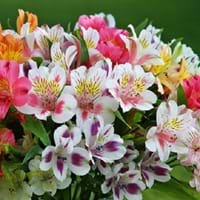Life Span
Perennial
Annual
Type
Perennial
Tender Perennial
Origin
Eastern Europe
South America, Argentina, Chile
Types
Not Available
Not Available
Habitat
Terrestrial
Cultivated Beds
USDA Hardiness Zone
4-9
8-11
Sunset Zone
1a, 1b, 2a, 2b, 3a, 3b, 4, 5, 6, 7, 8, 9, 10, 11, 12, 13, 14, 15, 16, 17, 18, 19, 20, 21, 22, 23, 24
H1, 5, 6, 7, 8, 9, 14, 15, 16, 17, 18, 19, 20, 21, 22, 23, 24
Habit
Clump-Forming
Clump-Forming
Flower Color
Yellow, Lavender, Blue Violet
Light Pink, Lavender, Orange Red
Flower Color Modifier
Bicolor
Multi-Color
Fruit Color
Not Available
Yellow green
Leaf Color in Spring
Green, Sea Green
Light Green, Gray Green
Leaf Color in Summer
Green, Sea Green
Light Green, Gray Green
Leaf Color in Fall
Green, Sea Green
Light Green, Gray Green
Leaf Color in Winter
Light Green
Gray Green, Yellow green
Leaf Shape
Lanceolate
Lanceolate
Plant Season
Spring, Summer
Summer
Sunlight
Full Sun, Partial Sun
Full Sun, Partial Sun
Growth Rate
Medium
Medium
Type of Soil
Loam, Sand
Loam, Sand
The pH of Soil
Neutral
Acidic, Neutral
Soil Drainage
Well drained
Well drained
Bloom Time
Spring, Late Spring, Early Summer
Early Summer, Summer, Late Summer
Tolerances
Drought
Drought
Where to Plant?
Ground
Ground
How to Plant?
By dividing rhizomes, tubers, Seedlings
Seedlings
Plant Maintenance
Medium
Medium
Watering Requirements
Average Water Needs, Do Not over Water
Requires regular watering
In Summer
Lots of watering
Lots of watering
In Spring
Moderate
Moderate
In Winter
Average Water
Average Water
Soil pH
Neutral
Acidic, Neutral
Soil Type
Loam, Sand
Loam, Sand
Soil Drainage Capacity
Well drained
Well drained
Sun Exposure
Full Sun, Partial Sun
Full Sun, Partial Sun
Pruning
Remove damaged leaves, Remove dead branches, Remove dead leaves
Remove damaged leaves, Remove dead branches, Remove dead leaves
Fertilizers
All-Purpose Liquid Fertilizer
All-Purpose Liquid Fertilizer
Pests and Diseases
Red blotch
Red blotch
Plant Tolerance
Drought
Drought
Flower Petal Number
Single
Single
Fragrant Bark/Stem
No
Not Available
Foliage Texture
Coarse
Fine
Foliage Sheen
Matte
Matte
Attracts
Hummingbirds
Hummingbirds
Allergy
Skin irritation
angioedema, Rhinoconjunctivitis, Throat itching, Urticaria
Aesthetic Uses
Showy Purposes
Showy Purposes
Beauty Benefits
Not Available
Not Available
Environmental Uses
Air purification
Air purification
Medicinal Uses
No Medicinal Use
Not Available
Part of Plant Used
Not Available
Flowers, Root
Other Uses
Used as Ornamental plant
Decoration Purposes
Used As Indoor Plant
No
No
Used As Outdoor Plant
Yes
Yes
Garden Design
Alpine, Edging, Mixed Border, Rock Garden, Wall
Cutflower, Mixed Border
Botanical Name
IRIS pumila
ALSTROEMERIA ligtu
Common Name
Dwarf Iris
Lily-of-the-Incas, Peruvian-lily
In Hindi
Dwarf Iris
peruvian lily
In German
Zwergiris
peruanische Lilie
In French
Dwarf Iris
lis des Incas
In Spanish
Enano Iris
lirio peruano
In Greek
νάνος Ίρις
περουβιανή κρίνος
In Portuguese
Dwarf Iris
lírio peruano
In Polish
Dwarf Iris
peruwiański lilia
In Latin
Iris Dwarf
Peruviani lilium
Phylum
Magnoliophyta
Magnoliophyta
Class
Liliopsida
Liliopsida
Family
Iridaceae
Liliaceae
Clade
Angiosperms, Monocots
Angiosperms, Monocots
Tribe
Irideae
Not Available
Subfamily
Iridoideae
Not Available
Number of Species
Not Available
Properties of Dwarf Iris and Peruvian-Lily
Wondering what are the properties of Dwarf Iris and Peruvian-Lily? We provide you with everything About Dwarf Iris and Peruvian-Lily. Dwarf Iris doesn't have thorns and Peruvian-Lily doesn't have thorns. Also Dwarf Iris does not have fragrant flowers. Dwarf Iris has allergic reactions like Skin irritation and Peruvian-Lily has allergic reactions like Skin irritation. Compare all the properties and characteristics of these two plants. Find out which of these plant can be used as indoor plant. If you are interested to decorate your house and garden, find out aesthetic uses, compare them and select the plant which will beautify your surrounding. Along with beautification, try comparing medicinal and edible uses of Dwarf Iris and Peruvian-Lily and you can choose the plant having best and most benefits.
Season and Care of Dwarf Iris and Peruvian-Lily
Season and care of Dwarf Iris and Peruvian-Lily is important to know. While considering everything about Dwarf Iris and Peruvian-Lily Care, growing season is an essential factor. Dwarf Iris season is Spring and Summer and Peruvian-Lily season is Spring and Summer. The type of soil for Dwarf Iris is Loam, Sand and for Peruvian-Lily is Loam, Sand while the PH of soil for Dwarf Iris is Neutral and for Peruvian-Lily is Acidic, Neutral.
Dwarf Iris and Peruvian-Lily Physical Information
Dwarf Iris and Peruvian-Lily physical information is very important for comparison. Dwarf Iris height is 10.20 cm and width 15.20 cm whereas Peruvian-Lily height is 38.10 cm and width 61.00 cm. The color specification of Dwarf Iris and Peruvian-Lily are as follows:
Dwarf Iris flower color: Yellow, Lavender and Blue Violet
Dwarf Iris leaf color: Green and Sea Green
Peruvian-Lily flower color: Light Pink, Lavender and Orange Red
- Peruvian-Lily leaf color: Light Green and Gray Green
Care of Dwarf Iris and Peruvian-Lily
Care of Dwarf Iris and Peruvian-Lily include pruning, fertilizers, watering etc. Dwarf Iris pruning is done Remove damaged leaves, Remove dead branches and Remove dead leaves and Peruvian-Lily pruning is done Remove damaged leaves, Remove dead branches and Remove dead leaves. In summer Dwarf Iris needs Lots of watering and in winter, it needs Average Water. Whereas, in summer Peruvian-Lily needs Lots of watering and in winter, it needs Average Water.





